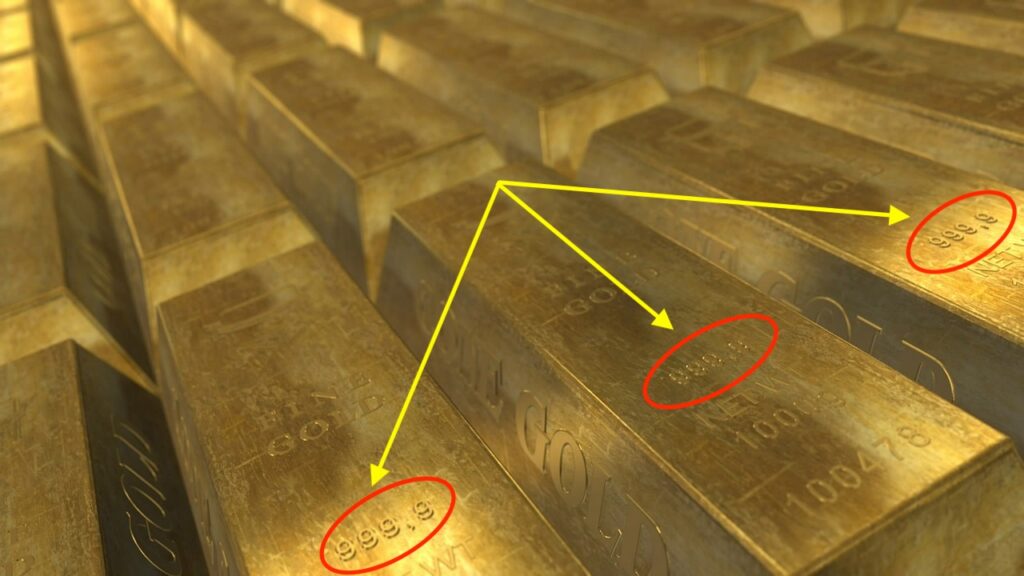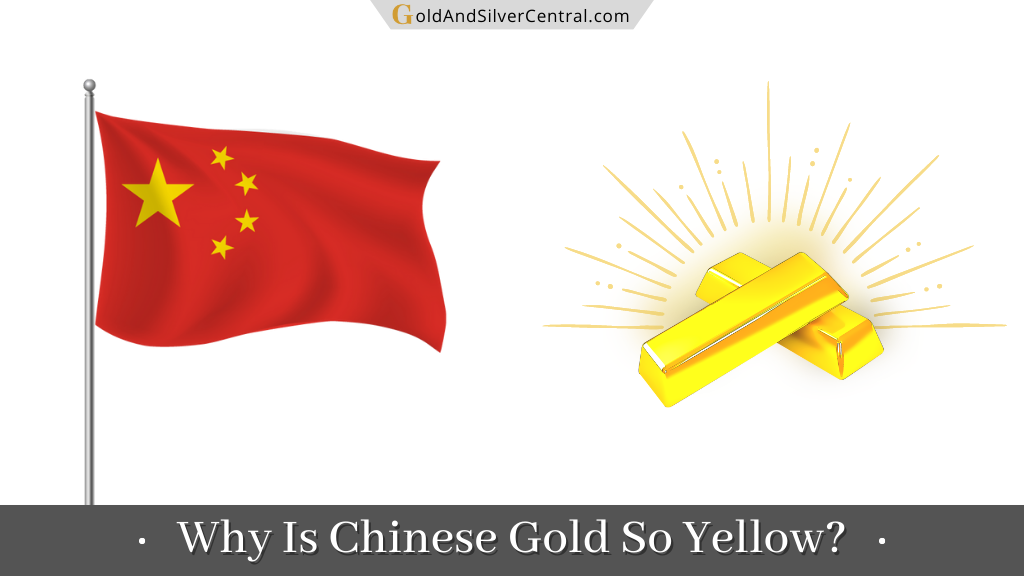Look:
When it comes to Asian gold, people wonder why is it more yellow, if it’s real or fake, and whether it’s good quality.
Today, we’ll cover the following questions:
- Why is Chinese gold so yellow?
- What is it made of?
- How pure is it?
Plus, we’ll talk about the symbolism, traditional techniques, and historical influences of the Chinese gold.
Without further ado, let’s get started.
Investing in precious metals? Start profiting with our #1 gold newsletter today!
The Purity Level
First things first:
Is Chinese gold good quality? (Especially considering its affordability.)
Yes, it is known for its high level of purity.
In case you didn’t know, gold purity is typically measured in karats, with 24 karat being considered the purest form.
Now…
In China, the most common standard is 24 karats, often referred to as “999”. This means that it is composed of 99.9% pure gold.
The country has a long history of production and consumption of this precious metal, and it places great importance on its quality.
Just like Thailand, it’s established strict regulations to make sure the shiny metal products meet the specified quality standards, enforced by government agencies like China Gold Association and the Shanghai Gold Exchange.
How Is Chinese Gold Marked?
And is Chinese gold real or fake?
Look:
Just because its bright yellow, doesn’t mean it’s not real.
And when it comes to bars, you’ll notice they are marked and serialized before being placed on the market. This is important for security, coding, and traceability reasons.
(Although this rule applies to each ingot from any country really, not just China.)
Same goes for purity information markings. Chinese jewelry and investment products are typically stamped with numbers indicating their purity level.
Chinese gold purity marks can look like this:

For example, “999” is commonly used for 24 karat gold, “990” for 23 karat, “985” for 22 karat, and so on.
That way you can know the exact products and jewelry you buy.
It’s important to note that while Chinese gold is generally of high purity, there may still be variations in quality levels depending on the specific product and manufacturer.
As with any precious metal purchase, it’s important to buy from reputable sources and verify the authenticity of your goods through proper certification or testing methods.
What Is Chinese Gold Made Of?
So, why does Asian gold look different?
Composition, and specifically silver, is the answer why Chinese gold shines so brilliantly in its radiant yellow hue.
Just to give you a bit of background, gold, in its pure form, is a soft, yellow metal. However, impurities and the addition of alloys can influence its color and durability.
When it comes to Chinese gold, silver takes center stage.
By manually blending the metal with silver (and sometimes copper and zinc as well), we see that vibrant hue effect.
Have a look at the caratage and the percentage of elements that make the yellow gold:

But there’s also a geological property at play here.
For example, gold deposits in some regions of China may have higher levels of silver, copper or other metals, resulting in a more intense yellow color.
All in all:
Because China uses (or naturally has) a higher silver or copper amount, it contributes to its more intense yellow color, compared to the gold from Western countries that use less silver.
The use of different alloys and varying ratios of metals results in subtle but noticeable distinctions in color.
Middle Eastern gold, for example, leans towards a rich, reddish tone, thanks to higher proportions of copper added.
Beyond the color, the composition influences its durability and longevity.
In this case, silver helps enhance the strength of this shiny metal, making it possible for intricate and detailed designs.
It also contributes to the resilience of Chinese gold jewelry, making sure that it withstands the test of time.
Speaking of jewelry…
3 Traditional Techniques
The craftsmanship behind Chinese gold jewelry is pretty great.

The artisans have mastered and passed down through generations specialized methods to achieve the desired hue and brilliance, and create such stunning pieces.
These techniques involve a delicate balance of temperature manipulation, precise mixing of alloys, and meticulous craftsmanship.
Technique 1: Granulation
This intricate process involves attaching tiny granules of gold to a larger surface, creating ornate patterns and textures.
The use of this adds depth and visual interest to Chinese gold jewelry, while also showcasing the artistry and attention to detail.
Technique 2: Filigree Work
This one involves shaping thin wires of gold into delicate, lacy patterns that are then soldered onto the jewelry piece.
Yet another thing that showcases the dexterity and precision of the craftsmen.
Technique 3: Enamel
Chinese goldsmiths often incorporate enamel into their work.
Enamel, a colored glass-like material, is fused onto the gold surface to create vibrant and intricate designs and adds an interesting touch to Chinese gold jewelry.
Fun fact:
The aforementioned techniques have not only influenced jewelry-making but have also had an impact on other artistic ventures, such as furniture design, ceramic art, and even architecture.
And this cross-pollination has contributed to the richness and diversity of Chinese artistic heritage.
This leads us to the next topic…
Symbolic and Aesthetic Preferences
The truth is:
The vibrant yellow hue of Chinese gold is not only visually striking and an aesthetic preference, but also holds deep symbolic importance.
In China, this color is associated with luck, happiness, and vitality.
By incorporating silver and/or copper alloys into the gold, craftsmen create jewelry that embodies these positive qualities, making it even more cherished and meaningful.

Now, the symbolism of this color in Chinese culture traces its roots back to ancient times.
Yellow was historically reserved for the emperor, symbolizing imperial power and supreme status. It represented the center of the universe and was associated with the Earth element.
Therefore, owning and wearing yellow gold jewelry carried a sense of prestige and prosperity.
Historical influences have also impacted the aesthetics and color preferences.
Over the centuries, China has had cultural exchanges and interactions with neighboring countries, and these brought new artistic influences and techniques.
Next, the yellow color is also linked to the concept of Yin and Yang, representing the harmonious balance between opposites. It embodies the qualities of warmth, light, and positive energy.
This association with positivity and fortune has made Chinese gold jewelry an integral part of cultural celebrations and rituals.
For example:
In traditional Chinese weddings, it is customary for the bride to receive a substantial amount of gold jewelry from her family, symbolizing their blessings for a prosperous and happy union.
And the radiant yellow color represents the joyful energy and good fortune that accompanies the couple on their journey together.
Why Is Chinese Gold Different?
In conclusion regarding the Chinese gold color, we hope now you understand why is Chinese gold so yellow and why the locals love this bright color.
There are regional factors, the specific techniques and blending of this precious metal with silver and/or copper, aesthetic preferences, and cultural symbolism at play here.
All in all, not only is Chinese gold affordable; it is an embodiment of tradition, artistry, and the rich cultural heritage.
May their jewelry bring you luck, happiness, and prosperity as well!
Over to you:
What are your thoughts on why is Asian gold so yellow? Is Asian gold good quality in your experience? Share your thoughts in the comments below!




